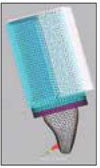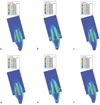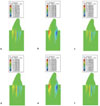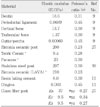1. de Castro Albuquerque R, Polleto LT, Fontana RH, Cimini CA. Stress analysis of an upper central incisor restored with different posts. J Oral Rehabil. 2003. 30:936–943.

2. Hunter AJ, Feiglin B, Williams JF. Effects of post placement on endodontically treated teeth. J Prosthet Dent. 1989. 62:166–172.

3. Ottl P, Hahn L, Lower HC, Fay M. Fracture characteristics of carbon fiber, ceramic and non-palladium endodontic post systems at monotonously increasing loads. J Oral Rehabil. 2002. 29:175–182.

4. Ko CC, Chu CS, Chung KH, Lee MC. Effects of posts on dentin stress distribution in pulpless teeth. J Prosthet Dent. 1992. 68:421–427.

5. Assif D, Gorfil C. Biomechanical considerations in restoring endodontically treated teeth. J Prosthet Dent. 1994. 71:565–567.

6. Caputo AA, Standlee JP. Biomechanics in Clinical Dentistry. 1987. Chicago: Quinte ssence Publishing Co, Inc;185–203.
7. Rosentritt M, Furer C, Behr M, Lang R, Handel G. Comparison of in vitro fracture strength of metallic and tooth-coloured posts and cores. J Oral Rehabil. 2000. 27:595–601.

8. Yaman SD, Alacam T, Yamen Y. Analysis of stress distribution in a maxillary central incisor subjected to various post and core applications. J Endod. 1998. 24:107–111.

9. Holmes DC, Diaz-Arnold AM, Leary JM. Influence of post dimension on stress distribution in dentin. J Prosthet Dent. 1996. 75:140–147.

10. Pegoretti A, Fambri L, Zappini G, Bianchetti M. Finite element analysis of a glass fibre reinforced composite endodontic post. Biomaterials. 2002. 23:2667–2682.

11. Eskitascioglu G, Belli S, Kalkan M. Evaluation of two post core systems using two different methods (fracture strength test and a finite elemental stress analysis). J Endod. 2002. 28:629–633.

12. Boschian Pest L, Guidotti S, Pietrabissa R, Gandliani M. Stress distribution in a post-restored tooth using the three-dimensional finite element method. J Oral Rehabil. 2006. 33:690–697.

13. Manning KE, Yu DC, Yu KC, Kwan EW. Factors to consider for predictable post and core buildups of endodontically treated teeth. Part II: clinical application of basic concepts. J Can Dent Assoc. 1995. 61:696–701. 703705–707.
14. Sorrentino R, Salameh Z, Apicella D, Auriemma T, Zarone F, Apicella A, Ferrari M. Three-dimensional finite element analysis of stress and strain distributions in post-and-core treated maxillary central incisors. J Adhes Dent. 2007. 9:527–536.
15. Sorrentino R, Aversa R, Ferro V, Auriemma T, Zarone F, Ferrari M, Apicella A. Three-dimensional finite element analysis of strain and stress distributions in endodontically treated maxillary central incisors restored with different post, core and crown materials. Dent Mater. 2007. 23:983–993.

16. Pierrisnard L, Bohin F, Renault P, Barquins M. Corono-radicular reconstruction of pulpless teeth: a mechanical study using finite element analysis. J Prosthet Dent. 2002. 88:442–448.

17. Asmussen E, Peutzfeldt A, Sahafi A. Finite element analysis of stresses in endodontically treated, dowel-restored teeth. J Prosthet Dent. 2005. 94:321–329.

18. Eskitascioglu G, Usumez A, Sevimay M, Soykan E, Unsal E. The influence of occlusal loading location on stresses transferred to implant- supported prostheses and supporting bone: A three-dimensional finite element study. J Prosthet Dent. 2004. 91:144–150.

19. Park JK, Hur B, Kim SK. The influence of combining composite resins with different elastic modulus on the stress distribution of class V restoration: A three-dimensional finite element study. J Korean Acad Conserv Dent. 2008. 33:184–197.

20. Park CS, Hur B, Kim KH, Son K, Park JK. The influence of occlusal load on stress distribution of cervical composite resin restorations: A three-diemnsional finite element study. J Korean Acad Conserv Dent. 2008. 33:246–257.

21. Sorensen JA, Engelman MJ. Ferrule design and fracture resistance of endodontically treated teeth. J Prosthet Dent. 1990. 63:529–536.

22. Ausiello P, Gee AJ, Rengo S, Davidson CL. Fracture resistance of endodontically treated premolars adhesively restored. Am J Dent. 1997. 10:237–241.
23. Sahafi A, Peutzfeldt A, Ravnholt G, Asmussen E, Gotfredsen K. Resistance to cyclic loading of teeth restored with posts. Clin Oral Investig. 2005. 9:84–90.

24. Eraslan O, Aykent F, Yücel MT, Akman S. Finite element analysis of the effect of ferrule height on stress distribution at post-and-core restored all-ceramic anterior crowns. Clin Oral Investig. 2008. 08. 12. [Epub ahead of print].
25. Ho MH, Lee SY, Chen HH, Lee MC. Three-dimensional finite element analysis of the effects of posts on stress distribution in dentin. J Prosthet Dent. 1994. 72:367–372.

26. Mannocci F, Ferrari M, Watson TF. Intermittent loading of teeth restored using quartz fiber, carbon-quartz fiber, and zirconium dioxide ceramic root canal posts. J Adhes Dent. 1999. 1:153–158.
27. Asmussen E, Peutzfeldt A, Heitmann T. Stiffness, elastic limit, and strength of newer types of endodontic posts. J Dent. 1999. 27:275–278.

28. Toksavul S, Zor M, Toman M, Gunror MA, Nergiz I, Artunc C. Analysis of dentinal stress distribution of maxillary central incisors subjected to various post-and-core applications. Oper Dent. 2006. 31:89–96.

29. Park JK, Hur B, Kim SK. Stress distribution of class composite resin restorations A three-dimensional finite element study. J Korean Acad Conserv Dent. 2008. 33:28–38.

30. Barjau-Escribano A, Sancho-Bru JL, Forner-Navarro L, Rodriguez-Cervantes PJ, Perez-Gonzalez A, Sanchez-Marin FT. Influence of prefabricated post
material on restored teeth: fracture strength and stress distribution. Oper Dent. 2006. 31:47–54.





 PDF
PDF ePub
ePub Citation
Citation Print
Print










 XML Download
XML Download